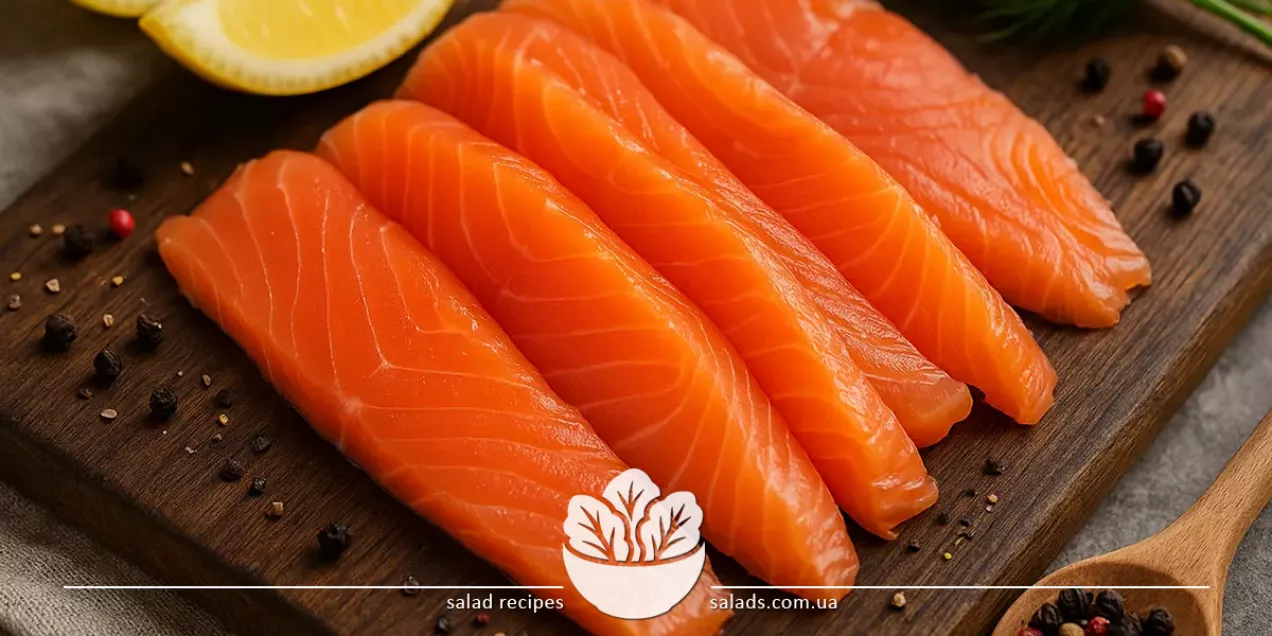
Lightly Salted Salmon

Lightly salted salmon is a delicacy fish product made by lightly salting fresh fillet without heat treatment. This method preserves the juiciness, natural texture, and rich flavor typical of red fish. Lightly salted salmon is used in a wide range of dishes – from classic appetizers and salads to sushi, rolls, and refined bruschetta. It combines nutritional value, aesthetics, and ease of preparation. Other types of this valuable fish can be found in the salmon category on the website.
Salad Recipes with Lightly Salted Salmon
Composition and Nutritional Value
Lightly salted salmon is one of the most nutritious fish products. 100 grams contain about 20 g of complete protein and up to 12 g of fats, with a significant portion being omega-3 fatty acids. These support the heart, blood vessels, and brain, reduce inflammation, and improve skin health. Salmon is also rich in vitamins A, D, B6, B12, and trace elements such as selenium, iodine, iron, and zinc. Due to its preparation method – light salting without heat – salmon retains maximum nutrients and has a tender, slightly buttery texture. Its flavor is delicate, with a subtle saltiness, allowing it to pair well with both simple and gourmet components. It tastes best in cold dishes but can also be added to hot ones like poached eggs or pasta. In dietary and festive meals, lightly salted salmon is often combined with other seafood. An interesting option is pairing it with frozen squid – the contrast of textures and the mild marine aftertaste make it suitable for light salads, appetizers, or rice-free rolls. This combination is not only tasty but also highly nutritious.
Serving in Appetizers and Festive Dishes
Lightly salted salmon is one of the most popular ingredients for sophisticated appetizers. It is used to garnish canapés, tartlets, mini-sandwiches, rolls, and appetizer wraps made from lavash or pancakes. In such dishes, salmon requires no complex additions – a bit of cream cheese, a sprig of herbs, or a few drops of lemon juice are enough to highlight its natural flavor. Bruschetta with salmon, cream cheese, and avocado or tartlets with mousse and red fish are especially popular. These are not only delicious but also visually appealing. Due to its tender texture, salmon is easy to slice, roll into roses, or form into neat rolls. It pairs well with creamy, cheesy, or horseradish sauces. Surprisingly but effectively, salmon can be combined with liver-based products, such as beef liver. In salads or appetizers, these two ingredients create a strong protein duo – rich yet diverse in taste, they complement each other well. This is a great option for culinary experiments that combine the delicacy of marine fish with the depth of meaty flavors.
Pairing with Other Fish Products
Lightly salted salmon pairs well not only with vegetables or dairy products but also with other types of fish and seafood. This approach is common in restaurant cuisine, where layered or assorted dishes are created using several fish ingredients. Differences in texture, fat content, and saltiness allow for new gastronomic effects, expanding flavor boundaries. Salmon pairs especially well with rich and soft-textured products such as canned cod liver. In these combinations, the softness and fat of one ingredient are balanced by the density and elasticity of the other. This is useful for salads, canapés, stuffed pancakes, or even pâtés where the two ingredients are mixed and seasoned with lemon juice, oil, or sauce. Combining lightly salted salmon with canned cod liver is an example of a rich yet balanced flavor. This duo is suitable for festive tartlets, appetizer rolls, or spreads. Combined with herbs and whole-grain mustard, the dish gains depth and a rich protein-fat base, perfect for a hearty snack or elegant presentation.
Salmon in Dishes with Grains and Cereals
Lightly salted salmon pairs wonderfully with grains and cereals, creating nutritionally balanced and texturally appealing dishes. Thanks to its high protein and healthy fat content, salmon complements the slow carbohydrates in grains, forming a complete meal. These combinations are common in healthy diets, fitness menus, and health-focused cafes. The most popular pairings include salmon with buckwheat, bulgur, quinoa, or classic white rice. These ingredients can be served warm or cold – in bowls, salads, or main dishes. Salmon can be sliced or cubed, or mixed into grains for even flavor distribution. Dishes based on white rice are especially popular – in sushi and rolls, or as bowls and rice salads. Here, salmon serves as the main protein source, while rice provides a soft, neutral base for the fish flavor. Additional ingredients like soy sauce, avocado, sesame, or seaweed help highlight key flavor notes.
Flavor Balance and the Role of Seasonings
The flavor of lightly salted salmon is rich yet delicate, so seasoning should be handled carefully. Commonly used are neutral or refreshing additions that do not overpower the fish’s natural aroma: lemon juice, horseradish, fresh dill, basil, soy sauce, or honey-mustard dressings. These accents enhance the flavor while maintaining overall harmony. In cold dishes, salmon is almost always paired with fat – cream cheese, butter, or avocado. However, salt still plays an important role, even in a lightly salted product. It can intensify the natural saltiness or balance it using other components like unsalted cheese, vegetables, or rice. In baked dishes or omelets, salt brings out the fish flavor more prominently. A fundamental element for fine-tuning the taste is salt. It is appropriate even in dishes with lightly salted salmon – used in small amounts for accent or in marinades for balance. The key is moderation, to avoid overpowering the fish’s natural delicacy, which is the main value of this ingredient.